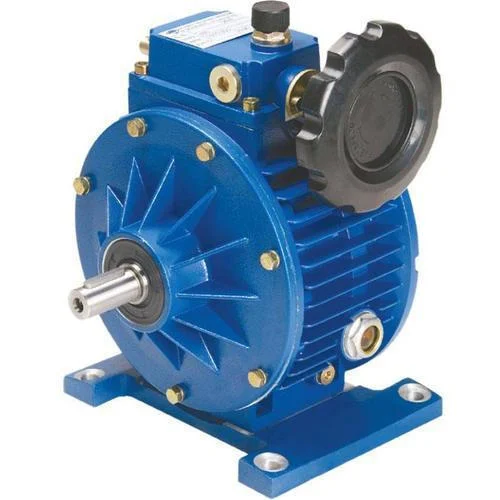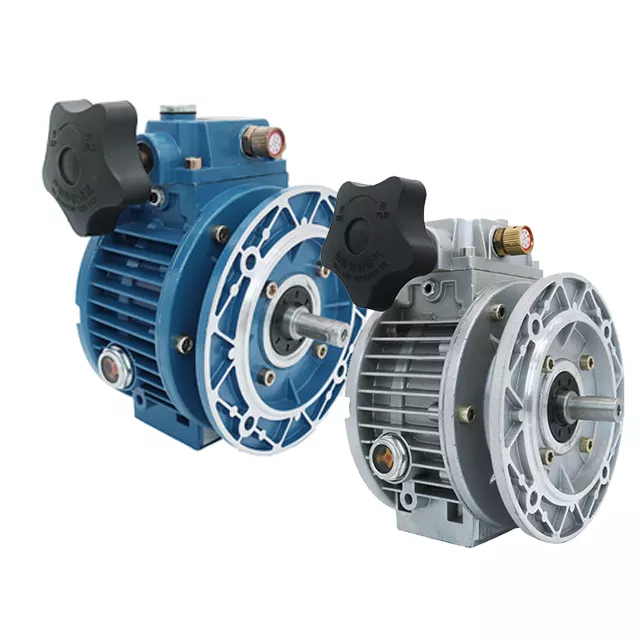Product Description
|
item |
value |
|
Warranty |
1 year |
|
Applicable Industries |
Manufacturing Plant, Construction works , Energy & Mining, Other |
|
Customized support |
OEM |
|
Gearing Arrangement |
Worm |
|
Place of CHINAMFG |
ZheJiang , China |
|
Input speed |
1500 |
|
Output speed |
1.3-193rpm |
|
Product name |
Udl Variable Speed |
|
MOQ |
10pcs |
|
Color |
Customization |
FAQ
Q1:Are you a manufacturer or trading company?
Yes, We are a leading manufacturer specialized in production of various kinds of small and medium-sized
motor.
Q2:How to choose a gearbox which meets our requirement?
You can refer to our catalogue to choose the gearbox or we can help to choose when you provide
the technical information of required output torque, output speed and motor parameter etc.
Q3:What information shall we give before placing a purchase order?
a) Type of the gearbox, ratio, input and output type, input flange, mounting position, and motor information etc.
b) Housing color.
c) Purchase quantity.
d) Other special requirements.
Q4:What industries are your gearboxes being used?
Our gearboxes are widely used in the areas of textile, food processing, beverage, chemical industry, escalator,automatic storage equipment, metallurgy, tabacco, environmental protection, logistics and etc.
Q5:How about your delivery time?
For micro brush dc gear motor, the sample delivery time is 2-5 days, bulk delivery time is about 15-20 days, depends on the order qty. For brushless dc motor, the sample deliver time is about 10-15 days; bulk time is 15-20 days.Please take the sales confirmation for final reference.
Q6:What’s your warranty terms?
One year
/* January 22, 2571 19:08:37 */!function(){function s(e,r){var a,o={};try{e&&e.split(“,”).forEach(function(e,t){e&&(a=e.match(/(.*?):(.*)$/))&&1
| Application: | Motor, Electric Cars, Motorcycle, Machinery, Marine, Agricultural Machinery, Car |
|---|---|
| Function: | Distribution Power, Clutch, Change Drive Torque, Change Drive Direction, Speed Changing, Speed Reduction, Speed Increase |
| Layout: | as for Request |
| Hardness: | Hardened Tooth Surface |
| Installation: | Horizontal Type |
| Step: | Stepless |
| Samples: |
US$ 65/Piece
1 Piece(Min.Order) | |
|---|
| Customization: |
Available
| Customized Request |
|---|

How do variator gearboxes ensure efficient power transmission and speed regulation?
Variator gearboxes are designed to ensure efficient power transmission and speed regulation through a combination of mechanical principles and control mechanisms. Here’s how they achieve these objectives:
Efficient Power Transmission:
Variator gearboxes employ various mechanisms to ensure efficient power transmission from the input to the output shaft. These mechanisms minimize energy losses and maximize the transfer of mechanical power. Here are a few key factors that contribute to efficient power transmission:
- Optimized Gear Design: Variator gearboxes are engineered with carefully designed gear profiles, tooth shapes, and gear ratios. These design elements help to reduce friction, minimize backlash, and improve the meshing efficiency between the gears. By optimizing the gear design, variator gearboxes can achieve higher power transmission efficiency.
- High-Quality Bearings: Variator gearboxes utilize high-quality bearings that reduce friction and allow smooth rotation of the gears and shafts. Well-lubricated bearings minimize energy losses due to friction, thereby improving overall power transmission efficiency.
- Lubrication Systems: Proper lubrication is essential for efficient power transmission in variator gearboxes. Lubricants reduce friction and wear between moving components, ensuring smooth operation and minimizing energy losses. Variator gearboxes often incorporate dedicated lubrication systems that deliver lubricants to critical areas, optimizing power transmission efficiency and extending the lifespan of the gearbox.
- Material Selection: The choice of materials in variator gearboxes plays a significant role in power transmission efficiency. High-strength and low-friction materials are often used for gears, shafts, and other critical components to minimize energy losses through friction and maximize power transfer.
- Minimization of Internal Losses: Variator gearboxes are designed to minimize internal losses caused by factors such as windage, churning, and fluid flow resistance. Streamlined housing designs, efficient cooling systems, and optimized fluid dynamics within the gearbox contribute to reducing these losses, resulting in improved power transmission efficiency.
Speed Regulation:
Variator gearboxes excel in speed regulation by providing precise and adjustable speed control according to the requirements of the application. The following features enable accurate speed regulation:
- Continuous Adjustment: Variator gearboxes offer continuous and stepless adjustment of the gear ratio or speed control mechanism. This allows for fine-tuning the output speed to match the specific speed requirements of the application. Continuous adjustment ensures that the desired speed can be precisely achieved, enabling effective speed regulation.
- Responsive Control Mechanisms: Variator gearboxes incorporate control mechanisms that respond quickly to speed adjustment inputs. These mechanisms can be mechanical, hydraulic, electronic, or a combination of these. Responsive control systems enable rapid and accurate regulation of the output speed, ensuring precise speed control in real-time.
- Wide Speed Range: Variator gearboxes can offer a wide range of achievable speeds, allowing for flexibility in speed regulation. By adjusting the gear ratio or other speed control mechanisms, variator gearboxes can cover a broad range of speed requirements, making them versatile in applications where speed variation is essential.
- Stable Speed Maintenance: Variator gearboxes are designed to maintain the selected speed setting with high stability. Once the desired speed is achieved, the gearbox is engineered to minimize speed variations due to external load changes or disturbances. This stability ensures that the output speed remains consistent, contributing to reliable speed regulation.
- Feedback and Control Systems: Some variator gearboxes incorporate feedback and control systems that monitor the output speed and adjust the gear ratio or control parameters accordingly. These systems provide closed-loop control, constantly comparing the actual speed with the desired speed, and making adjustments to maintain accurate speed regulation even in the presence of external factors affecting the load or operating conditions.
By incorporating efficient power transmission mechanisms and precise speed regulation features, variator gearboxes can optimize energy transfer and maintain the desired speed levels in a wide range of applications. This enables them to deliver efficient power transmission while offering reliable and adjustable speed regulation.

Are there any limitations or drawbacks associated with variator gearbox systems?
Variator gearbox systems offer numerous advantages, but they also have certain limitations and drawbacks that should be considered. Here are some of the limitations and drawbacks associated with variator gearbox systems:
Limited Torque Capacity:
One limitation of variator gearboxes is their relatively limited torque capacity compared to some other types of gearboxes. Due to the design and construction of variator systems, they may not be suitable for applications that require extremely high torque transmission. In such cases, alternative gearbox systems with higher torque ratings may be more appropriate.
Restricted Speed Ratios:
Variator gearboxes typically have a limited range of achievable speed ratios compared to some other gearbox types. While they offer a continuous and stepless adjustment of the gear ratio, the maximum and minimum achievable ratios may be narrower compared to gearboxes with discrete gear steps. This limitation may restrict their suitability for certain applications that require extremely high or low speed ranges.
Complex Design and Maintenance:
Variator gearboxes can have a more complex design compared to conventional gearboxes. The presence of variable pulley systems, torque-sensing mechanisms, and control systems adds complexity to their construction. This complexity may require specialized knowledge and skills for maintenance and repairs. Additionally, the availability of spare parts and the cost of maintenance can be higher for variator gearboxes compared to simpler gearbox designs.
Potential for Heat Generation:
During operation, variator gearboxes can generate heat due to friction and mechanical losses. The continuous adjustment of the gear ratio and the interaction between the variable pulley system and the belt or chain can contribute to heat generation. Adequate cooling measures and lubrication systems may be necessary to dissipate heat effectively and prevent overheating, especially during prolonged operation at high speeds or under heavy loads.
Efficiency Losses:
While variator gearboxes can maintain reasonable power transmission efficiency, they may experience some efficiency losses compared to certain other gearbox types. The presence of additional components such as variable pulley systems, control mechanisms, and torque-sensing devices can introduce additional friction and mechanical losses, which can slightly reduce overall efficiency. However, advancements in technology and improved designs have mitigated this drawback to a significant extent in modern variator gearbox systems.
Cost Considerations:
Variator gearboxes can be more expensive compared to some traditional gearbox designs. The complexity of their construction, the need for precise control systems, and the use of specialized components can contribute to higher manufacturing and maintenance costs. Therefore, cost considerations should be taken into account when evaluating the feasibility of variator gearbox systems for specific applications.
Despite these limitations and drawbacks, variator gearbox systems continue to offer unique advantages in terms of continuous speed adjustment, efficient power transmission, and precise control. By carefully assessing the specific requirements of an application and considering the trade-offs, it is possible to determine whether a variator gearbox system is the most suitable choice.

How do variator gearboxes handle variations in speed and torque requirements?
Variator gearboxes are designed to handle variations in speed and torque requirements by providing adjustable speed control and flexible torque transmission. Here’s how they accomplish this:
Variator gearboxes handle variations in speed requirements through their unique design and operating principles. They offer continuously adjustable speed control, allowing for stepless variation within a certain range. This is achieved by employing mechanisms that can change the effective gear ratio between the input and output shafts. As the gear ratio is altered, the output speed of the gearbox changes accordingly.
One common method used by variator gearboxes is the manipulation of pulley or cone sizes. For example, in belt-and-pulley variators, the effective diameter of the pulleys can be adjusted by changing their position. This variation in pulley diameter modifies the speed ratio between the input and output, resulting in different output speeds. Similarly, in cone variators, the conical elements change their effective radius as they move closer or farther apart, enabling speed adjustment.
Additionally, variator gearboxes handle variations in torque requirements by providing flexible torque transmission capabilities. They can transmit high torque while maintaining efficiency, ensuring that the necessary power is delivered to the driven system. The specific torque handling capabilities depend on the design and construction of the variator gearbox.
Some variator gearboxes, such as cone variators, are known for their high torque capacity. The conical elements in these gearboxes can withstand substantial torque loads, making them suitable for applications that require robust torque transmission. Other types of variator gearboxes, such as disc variators or hydrostatic variators, are also designed to handle significant torque requirements efficiently.
Furthermore, variator gearboxes can be equipped with additional features to enhance torque transmission. For instance, certain variator gearboxes incorporate mechanisms like friction drives or hydraulic systems that can further optimize torque delivery and handling.
In summary, variator gearboxes handle variations in speed and torque requirements by providing continuously adjustable speed control and flexible torque transmission. Through the manipulation of pulley or cone sizes, variator gearboxes can adjust the effective gear ratio and achieve the desired output speed. Additionally, their design and construction allow them to transmit high torque efficiently, ensuring that the required power is delivered to the driven system. These capabilities make variator gearboxes versatile and adaptable in various applications where speed and torque variations are encountered.


editor by CX 2024-05-06
